Zhen Xing
StableAvatar: Infinite-Length Audio-Driven Avatar Video Generation
Aug 11, 2025Abstract:Current diffusion models for audio-driven avatar video generation struggle to synthesize long videos with natural audio synchronization and identity consistency. This paper presents StableAvatar, the first end-to-end video diffusion transformer that synthesizes infinite-length high-quality videos without post-processing. Conditioned on a reference image and audio, StableAvatar integrates tailored training and inference modules to enable infinite-length video generation. We observe that the main reason preventing existing models from generating long videos lies in their audio modeling. They typically rely on third-party off-the-shelf extractors to obtain audio embeddings, which are then directly injected into the diffusion model via cross-attention. Since current diffusion backbones lack any audio-related priors, this approach causes severe latent distribution error accumulation across video clips, leading the latent distribution of subsequent segments to drift away from the optimal distribution gradually. To address this, StableAvatar introduces a novel Time-step-aware Audio Adapter that prevents error accumulation via time-step-aware modulation. During inference, we propose a novel Audio Native Guidance Mechanism to further enhance the audio synchronization by leveraging the diffusion's own evolving joint audio-latent prediction as a dynamic guidance signal. To enhance the smoothness of the infinite-length videos, we introduce a Dynamic Weighted Sliding-window Strategy that fuses latent over time. Experiments on benchmarks show the effectiveness of StableAvatar both qualitatively and quantitatively.
Non-Uniform Class-Wise Coreset Selection: Characterizing Category Difficulty for Data-Efficient Transfer Learning
Apr 17, 2025Abstract:As transfer learning models and datasets grow larger, efficient adaptation and storage optimization have become critical needs. Coreset selection addresses these challenges by identifying and retaining the most informative samples, constructing a compact subset for target domain training. However, current methods primarily rely on instance-level difficulty assessments, overlooking crucial category-level characteristics and consequently under-representing minority classes. To overcome this limitation, we propose Non-Uniform Class-Wise Coreset Selection (NUCS), a novel framework that integrates both class-level and instance-level criteria. NUCS automatically allocates data selection budgets for each class based on intrinsic category difficulty and adaptively selects samples within optimal difficulty ranges. By explicitly incorporating category-specific insights, our approach achieves a more balanced and representative coreset, addressing key shortcomings of prior methods. Comprehensive theoretical analysis validates the rationale behind adaptive budget allocation and sample selection, while extensive experiments across 14 diverse datasets and model architectures demonstrate NUCS's consistent improvements over state-of-the-art methods, achieving superior accuracy and computational efficiency. Notably, on CIFAR100 and Food101, NUCS matches full-data training accuracy while retaining just 30% of samples and reducing computation time by 60%. Our work highlights the importance of characterizing category difficulty in coreset selection, offering a robust and data-efficient solution for transfer learning.
MagicMotion: Controllable Video Generation with Dense-to-Sparse Trajectory Guidance
Mar 20, 2025Abstract:Recent advances in video generation have led to remarkable improvements in visual quality and temporal coherence. Upon this, trajectory-controllable video generation has emerged to enable precise object motion control through explicitly defined spatial paths. However, existing methods struggle with complex object movements and multi-object motion control, resulting in imprecise trajectory adherence, poor object consistency, and compromised visual quality. Furthermore, these methods only support trajectory control in a single format, limiting their applicability in diverse scenarios. Additionally, there is no publicly available dataset or benchmark specifically tailored for trajectory-controllable video generation, hindering robust training and systematic evaluation. To address these challenges, we introduce MagicMotion, a novel image-to-video generation framework that enables trajectory control through three levels of conditions from dense to sparse: masks, bounding boxes, and sparse boxes. Given an input image and trajectories, MagicMotion seamlessly animates objects along defined trajectories while maintaining object consistency and visual quality. Furthermore, we present MagicData, a large-scale trajectory-controlled video dataset, along with an automated pipeline for annotation and filtering. We also introduce MagicBench, a comprehensive benchmark that assesses both video quality and trajectory control accuracy across different numbers of objects. Extensive experiments demonstrate that MagicMotion outperforms previous methods across various metrics. Our project page are publicly available at https://quanhaol.github.io/magicmotion-site.
Human2Robot: Learning Robot Actions from Paired Human-Robot Videos
Feb 23, 2025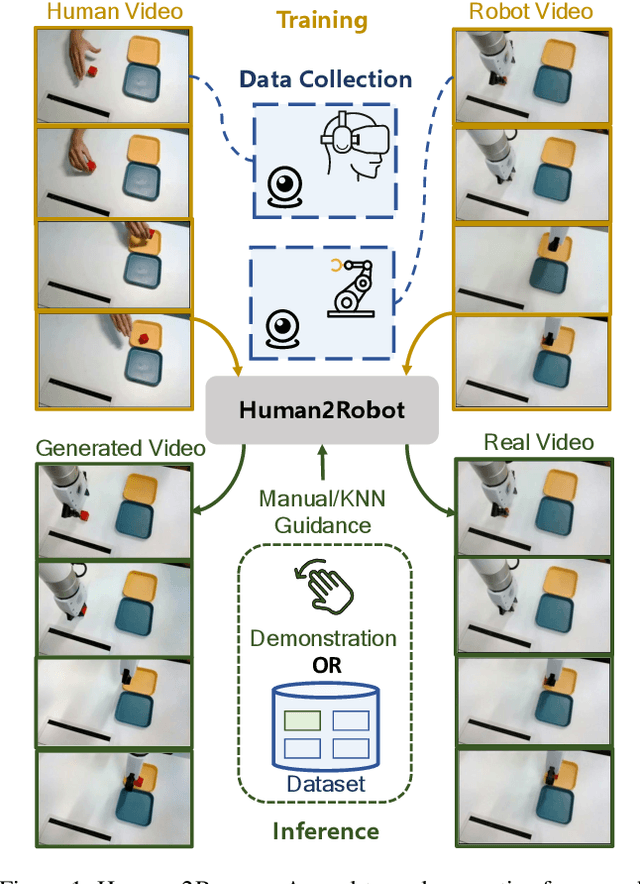



Abstract:Distilling knowledge from human demonstrations is a promising way for robots to learn and act. Existing work often overlooks the differences between humans and robots, producing unsatisfactory results. In this paper, we study how perfectly aligned human-robot pairs benefit robot learning. Capitalizing on VR-based teleportation, we introduce H\&R, a third-person dataset with 2,600 episodes, each of which captures the fine-grained correspondence between human hands and robot gripper. Inspired by the recent success of diffusion models, we introduce Human2Robot, an end-to-end diffusion framework that formulates learning from human demonstrates as a generative task. Human2Robot fully explores temporal dynamics in human videos to generate robot videos and predict actions at the same time. Through comprehensive evaluations of 8 seen, changed and unseen tasks in real-world settings, we demonstrate that Human2Robot can not only generate high-quality robot videos but also excel in seen tasks and generalize to unseen objects, backgrounds and even new tasks effortlessly.
StableAnimator: High-Quality Identity-Preserving Human Image Animation
Nov 26, 2024Abstract:Current diffusion models for human image animation struggle to ensure identity (ID) consistency. This paper presents StableAnimator, the first end-to-end ID-preserving video diffusion framework, which synthesizes high-quality videos without any post-processing, conditioned on a reference image and a sequence of poses. Building upon a video diffusion model, StableAnimator contains carefully designed modules for both training and inference striving for identity consistency. In particular, StableAnimator begins by computing image and face embeddings with off-the-shelf extractors, respectively and face embeddings are further refined by interacting with image embeddings using a global content-aware Face Encoder. Then, StableAnimator introduces a novel distribution-aware ID Adapter that prevents interference caused by temporal layers while preserving ID via alignment. During inference, we propose a novel Hamilton-Jacobi-Bellman (HJB) equation-based optimization to further enhance the face quality. We demonstrate that solving the HJB equation can be integrated into the diffusion denoising process, and the resulting solution constrains the denoising path and thus benefits ID preservation. Experiments on multiple benchmarks show the effectiveness of StableAnimator both qualitatively and quantitatively.
GenRec: Unifying Video Generation and Recognition with Diffusion Models
Aug 27, 2024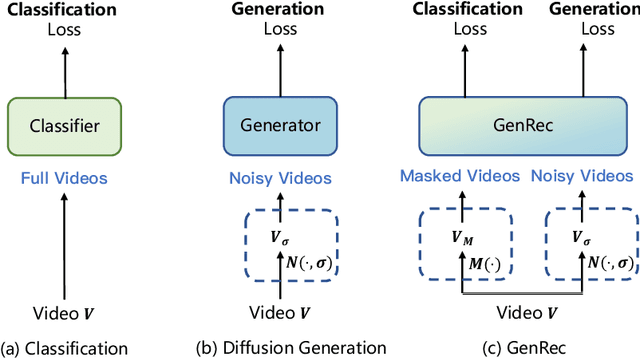

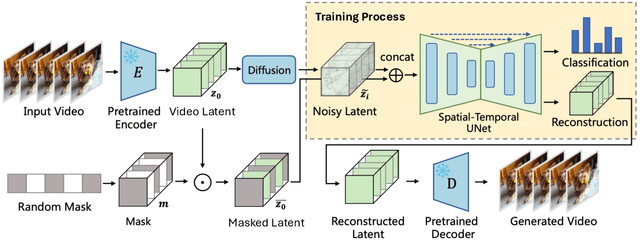

Abstract:Video diffusion models are able to generate high-quality videos by learning strong spatial-temporal priors on large-scale datasets. In this paper, we aim to investigate whether such priors derived from a generative process are suitable for video recognition, and eventually joint optimization of generation and recognition. Building upon Stable Video Diffusion, we introduce GenRec, the first unified framework trained with a random-frame conditioning process so as to learn generalized spatial-temporal representations. The resulting framework can naturally supports generation and recognition, and more importantly is robust even when visual inputs contain limited information. Extensive experiments demonstrate the efficacy of GenRec for both recognition and generation. In particular, GenRec achieves competitive recognition performance, offering 75.8% and 87.2% accuracy on SSV2 and K400, respectively. GenRec also performs the best class-conditioned image-to-video generation results, achieving 46.5 and 49.3 FVD scores on SSV2 and EK-100 datasets. Furthermore, GenRec demonstrates extraordinary robustness in scenarios that only limited frames can be observed.
Aligning Vision Models with Human Aesthetics in Retrieval: Benchmarks and Algorithms
Jun 13, 2024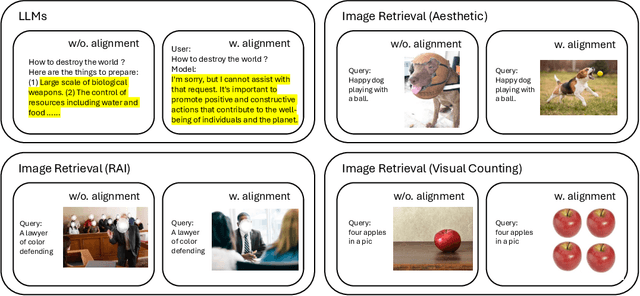



Abstract:Modern vision models are trained on very large noisy datasets. While these models acquire strong capabilities, they may not follow the user's intent to output the desired results in certain aspects, e.g., visual aesthetic, preferred style, and responsibility. In this paper, we target the realm of visual aesthetics and aim to align vision models with human aesthetic standards in a retrieval system. Advanced retrieval systems usually adopt a cascade of aesthetic models as re-rankers or filters, which are limited to low-level features like saturation and perform poorly when stylistic, cultural or knowledge contexts are involved. We find that utilizing the reasoning ability of large language models (LLMs) to rephrase the search query and extend the aesthetic expectations can make up for this shortcoming. Based on the above findings, we propose a preference-based reinforcement learning method that fine-tunes the vision models to distill the knowledge from both LLMs reasoning and the aesthetic models to better align the vision models with human aesthetics. Meanwhile, with rare benchmarks designed for evaluating retrieval systems, we leverage large multi-modality model (LMM) to evaluate the aesthetic performance with their strong abilities. As aesthetic assessment is one of the most subjective tasks, to validate the robustness of LMM, we further propose a novel dataset named HPIR to benchmark the alignment with human aesthetics. Experiments demonstrate that our method significantly enhances the aesthetic behaviors of the vision models, under several metrics. We believe the proposed algorithm can be a general practice for aligning vision models with human values.
AID: Adapting Image2Video Diffusion Models for Instruction-guided Video Prediction
Jun 10, 2024Abstract:Text-guided video prediction (TVP) involves predicting the motion of future frames from the initial frame according to an instruction, which has wide applications in virtual reality, robotics, and content creation. Previous TVP methods make significant breakthroughs by adapting Stable Diffusion for this task. However, they struggle with frame consistency and temporal stability primarily due to the limited scale of video datasets. We observe that pretrained Image2Video diffusion models possess good priors for video dynamics but they lack textual control. Hence, transferring Image2Video models to leverage their video dynamic priors while injecting instruction control to generate controllable videos is both a meaningful and challenging task. To achieve this, we introduce the Multi-Modal Large Language Model (MLLM) to predict future video states based on initial frames and text instructions. More specifically, we design a dual query transformer (DQFormer) architecture, which integrates the instructions and frames into the conditional embeddings for future frame prediction. Additionally, we develop Long-Short Term Temporal Adapters and Spatial Adapters that can quickly transfer general video diffusion models to specific scenarios with minimal training costs. Experimental results show that our method significantly outperforms state-of-the-art techniques on four datasets: Something Something V2, Epic Kitchen-100, Bridge Data, and UCF-101. Notably, AID achieves 91.2% and 55.5% FVD improvements on Bridge and SSv2 respectively, demonstrating its effectiveness in various domains. More examples can be found at our website https://chenhsing.github.io/AID.
FDGaussian: Fast Gaussian Splatting from Single Image via Geometric-aware Diffusion Model
Mar 15, 2024
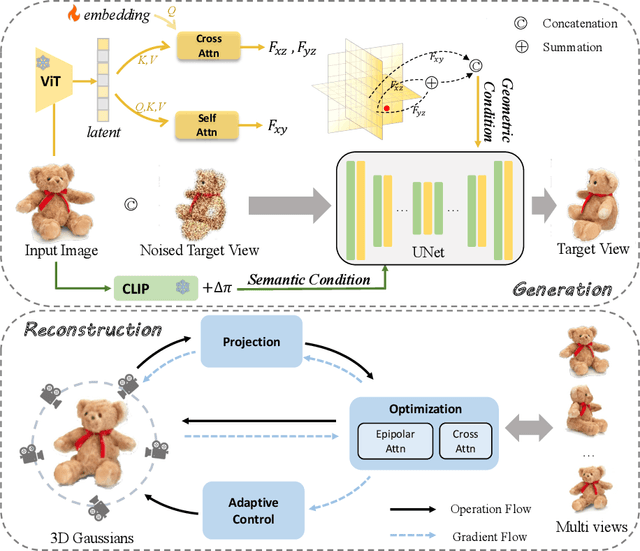


Abstract:Reconstructing detailed 3D objects from single-view images remains a challenging task due to the limited information available. In this paper, we introduce FDGaussian, a novel two-stage framework for single-image 3D reconstruction. Recent methods typically utilize pre-trained 2D diffusion models to generate plausible novel views from the input image, yet they encounter issues with either multi-view inconsistency or lack of geometric fidelity. To overcome these challenges, we propose an orthogonal plane decomposition mechanism to extract 3D geometric features from the 2D input, enabling the generation of consistent multi-view images. Moreover, we further accelerate the state-of-the-art Gaussian Splatting incorporating epipolar attention to fuse images from different viewpoints. We demonstrate that FDGaussian generates images with high consistency across different views and reconstructs high-quality 3D objects, both qualitatively and quantitatively. More examples can be found at our website https://qjfeng.net/FDGaussian/.
VIDiff: Translating Videos via Multi-Modal Instructions with Diffusion Models
Nov 30, 2023
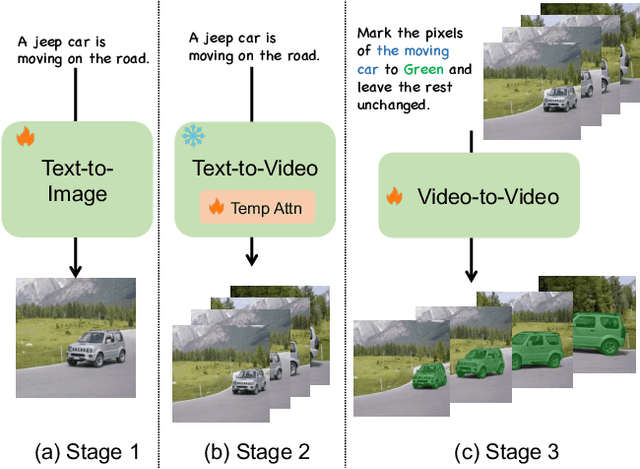

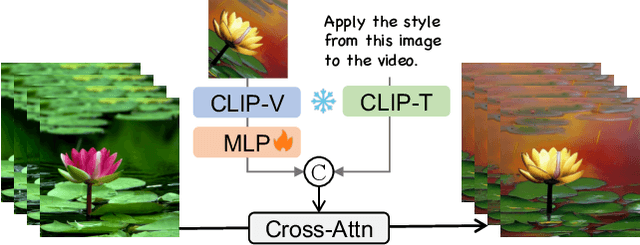
Abstract:Diffusion models have achieved significant success in image and video generation. This motivates a growing interest in video editing tasks, where videos are edited according to provided text descriptions. However, most existing approaches only focus on video editing for short clips and rely on time-consuming tuning or inference. We are the first to propose Video Instruction Diffusion (VIDiff), a unified foundation model designed for a wide range of video tasks. These tasks encompass both understanding tasks (such as language-guided video object segmentation) and generative tasks (video editing and enhancement). Our model can edit and translate the desired results within seconds based on user instructions. Moreover, we design an iterative auto-regressive method to ensure consistency in editing and enhancing long videos. We provide convincing generative results for diverse input videos and written instructions, both qualitatively and quantitatively. More examples can be found at our website https://ChenHsing.github.io/VIDiff.
 Add to Chrome
Add to Chrome Add to Firefox
Add to Firefox Add to Edge
Add to Edge